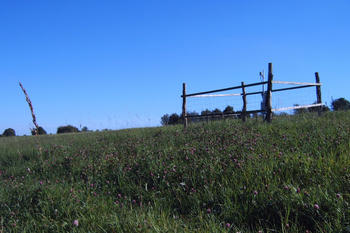Diversity Is the Best Service Provider
Researchers from Freie Universität publish studies on biodiversity.
Jan 26, 2017
Grassland space at the Hainich-Dün exploratory with a fenced-in weather station.
Image Credit: Ilja Sonnemann
How does biodiversity within cultural landscapes affect people? Researchers from the Dahlem Centre of Plant Sciences (DCPS) at Freie Universität studied the influence of biodiversity on “ecosystem services” as part of an international team of researchers. Among the team’s other findings, it became apparent how important diversity really is among plant-eating insects and microorganisms that had previously been disregarded.
The Schorfheide-Chorin UNESCO biosphere reserve is a popular excursion destination north of Berlin. For nearly ten years now, the region has been visited regularly, not only by nature enthusiasts and hikers, but also by scientists and researchers. It is home to one of three “biodiversity exploratories.”
Additional exploratories are located in the Hainich-Dün region of the state of Thuringia and in the Swabian Alb biosphere reserve, in Baden-Württemberg. They receive funding from the German Research Foundation (DFG) as part of a joint project and offer scientists from a number of different disciplines the opportunity to study questions of biodiversity and how it affects ecosystem processes.
Over a total of 150 grassland areas in these three regions, an international team of researchers headed by Santiago Soliveres of the University of Bern studied the connection between biodiversity and ecosystem services. That means the services provided by nature that benefit us as people. They fall into four categories.
The recreational value offered by a field in bloom is among the cultural ecosystem services. If that field is used to feed livestock instead, researchers consider that to be a “provisioning” service. There are also supporting services, including increasing the soil’s nitrogen content, and regulating services, like pest control.
Multiple Trophic Groups Studied for the First Time
The effects of biodiversity on these services had previously only been studied based on individual groups of organisms, such as plants. A study entitled “Biodiversity at multiple trophic levels is needed for ecosystem multifunctionality,” which was published recently in the journal Nature, is the first to take account of nine “trophic” groups in the food web of a grassland area (from the ancient Greek trophe, for food or feeding).
In addition to plants, the study covers plant eaters, plant symbionts, saprophytic microorganisms (microorganisms that live on dead or decaying organic matter), soil organisms that live on bacteria or dead plants and animals, and predators. The researchers collected data on 4,600 different species of animals, plants, and microorganisms in all. The researchers from the Dahlem Centre of Plant Sciences (DCPS) who were involved in the project were especially interested in organisms living belowground.
For this study, Professor Susanne Wurst and her colleagues within the “Functional Biodiversity” working group studied the spread of different insect larvae in grasslands used in various ways. Examples included root eaters, such as click beetle larvae, also known as wireworms, Bibionidae larvae, which live on decomposing organic matter, and predatory ground beetle larvae.
Researchers from the Plant Ecology working group headed by Professor Matthias Rillig focused instead on the connection between plant diversity and a type of fungi known as arbuscular mycorrhizae, which live in symbiosis with roots.
Biological Factors Have Pronounced Effects on Ecosystem Services
The study’s results show that the main services promoted by biodiversity in a grassland setting are regulating and cultural services. By contrast, supporting services are influenced by the number of individuals within a specific trophic group.
The researchers also discovered that biodiversity across multiple trophic groups is more important to ecosystem services than high diversity in just one group, such as plants. Each service is affected by three different groups on average. In addition, each trophic group affects at least one service. Plants, leaf-eating insects, and saprophytic microorganisms turned out to be especially important groups.
The field studies also showed that biodiversity and the number of individuals affect ecosystem services just as much as non-biological factors such as the pH value of the soil or the intensity of land use.
The study’s authors point out that it is important to maintain as many species and individuals from different trophic groups as possible if an ecosystem is to provide a diverse range of services. This also includes inconspicuous organisms such as microorganisms, which have been widely ignored in past biodiversity measures, and plant-eating insects, which in many cases are only known for the pests among them. All of them contribute to the diverse range of ecosystem services that benefit humankind.
Further Information
- Professor Dr. Susanne Wurst, Institute of Biology, Freie Universität Berlin, Königin-Luise-Str. 1 - 3, 14195 Berlin,Tel.: +49 +30 838 53994, Email: s.wurst@fu-berlin.de
- Prof. Dr. Matthias C. Rillig, Institute of Biology - Ecology of Plants, Freie Universität Berlin, Altensteinstr. 6, 14195 Berlin-Dahlem, Tel.: +49 30 838-53165, Email: rillig@zedat.fu-berlin.de

